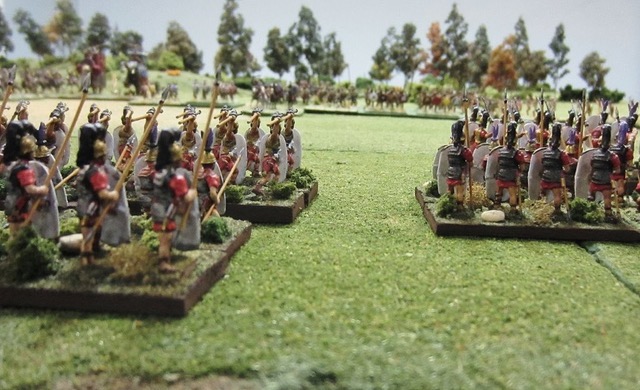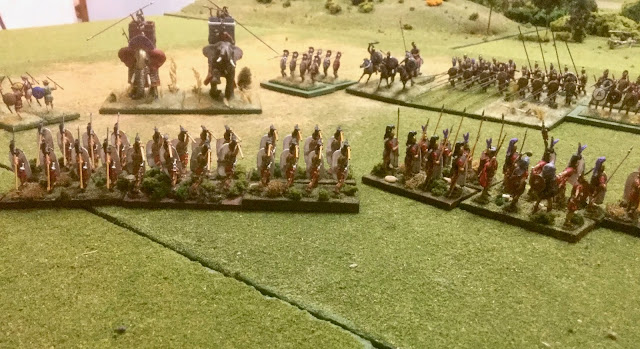The rules were developed from a friend who authored the original based on the first version of DBA. He is also a 6mm solo gamer in DBA and his goal was to keep it simple. He introduced me to the rules when we decided to do his rules in 1\72 scale.
After I learned what he had in mind he turned them over to me for further modification.
I learned early on it is not wise to mess too much with the DBA math. If you do, you lose all semblance of what DBA was about.
My only two objections\annoyances to DBA in it's original form are; 1) I do not care for unhistorical match ups and 2) I don't like the element limitation and the visual associated with single bases.
To "fix" the first annoyance I decided to use the Command and Colors Ancients scenarios and adapt them to a war-game table that measures 4' by 4'. Adapting CCA scenarios requires some historical knowledge because the terminology in the game systems do not match but it's not all that hard to make valid comparisons.
To "fix" the second annoyance I decided to add a second base to the element types that would not ordinarily get them for the rank bonus. The second base for the types are meaningless for game purposes. You simply get more of a "unit feel" than you do with single element bases.
Here's a couple of examples:
 |
| Two elements of Ps archers flanked by elements of Legionaries. The second rank does not matter in the least. It's just for looks. |
 |
| Four elements of Romans, not eight! |
 |
| Chariots and Elephants never get the extra base for looks. These are three elements of LtChar. |
 |
| Two elements of El vs three elements of Bds. |
 |
| Pks in three ranks and hoplites in two ranks for a bonus. The two Triarii elements on the left would also gain a bonus. The Hastatus (Bds) elements on the right do not. |
Melee
|
Vs Foot
|
Vs Horse
|
Bd
|
5
|
3
|
El
|
4
|
5
|
Sp
|
4
|
4
|
LtSp
|
3
|
3
|
Kn, Pk
|
3
|
4
|
Cv. Ch
|
3
|
3
|
Ax
|
3
|
2
|
Bw (R=6”)
|
4
|
4
|
LH, PS
|
2
|
2
|
Cam
|
3
|
2
|
Wb
|
3
|
2
|
Melee Modifiers
+1 Second rank of SP, LtSp, Wb vs all foot except Bw and Ps, +1 vs Kn, Cat, El
+1 Uphill
+1 General attached (unless an individual element)
+3 PK in 3 ranks (except against Ps and Bw, +2 vs Kn, Cat, El
+1 Ax. Bd, Lt\Sp, Sp, with a rear rank of Ps vs mounted, El, Wb
-1 flank
-1 to defender for each flank over lapped
-1 to defender for each BW element aiding firing (max of 2, but note priority target rule)
-1 Pk recoiled (permanent)
-2 art, Bd, Pk, Sp, Lt/Sp or mounted in melee with enemy in bad going.
+1 Second rank of SP, LtSp, Wb vs all foot except Bw and Ps, +1 vs Kn, Cat, El
+1 Uphill
+1 General attached (unless an individual element)
+3 PK in 3 ranks (except against Ps and Bw, +2 vs Kn, Cat, El
+1 Ax. Bd, Lt\Sp, Sp, with a rear rank of Ps vs mounted, El, Wb
-1 flank
-1 to defender for each flank over lapped
-1 to defender for each BW element aiding firing (max of 2, but note priority target rule)
-1 Pk recoiled (permanent)
-2 art, Bd, Pk, Sp, Lt/Sp or mounted in melee with enemy in bad going.
Distant Shooting Factors (BW)
-1 Bd, El
+1 General element shot at
+2 Ft in camp

-1 Bd, El
+1 General element shot at
+2 Ft in camp
Melee Results
- * Element hit in rear is destroyed
- * Element hit in front or flank, fight front first, if
defeated element destroyed, if not fight flank - * 1-1 recoil base\block width unless
* EL is destroyed by Ps
* Kn is destroyed by Lh, Bw, El
* AX is destroyed by Lh, Bw, El, Mtd in good going * Bw is destroyed by H\Char or Cv
* Ps is destroyed by Kn, Cv in good going - * 2-1
* All destroyed except...
- * LH is destroyed by any Mtd. or BW, otherwise flee
10” - * PS is destroyed by any Mtd, AX, or other PS,
otherwise flee 6 Destruction via Morale\Recoils Element Rating
- * LH is destroyed by any Mtd. or BW, otherwise flee
- Destruction via Morale\Recoils Element Rating
1st Recoil 2nd Recoil 3rd Recoil 4th Recoil
Superior NE. NE. -1 CF. -2 CF
Ordinary NE. -1 CF. -2 CF. Elim
Inferior. -1 CF. -2 CF. Elim
Ordinary NE. -1 CF. -2 CF. Elim
Inferior. -1 CF. -2 CF. Elim
NE-No Effect
CF=both combat factors
Recoils need not be consecutive
All elements are assigned a morale rating based on historical knowledge of the battle in question. The vast majority of elements are ordinary. The recoil system here prevents an endless shoving match and make a recoil count for something.
CF=both combat factors
Recoils need not be consecutive
All elements are assigned a morale rating based on historical knowledge of the battle in question. The vast majority of elements are ordinary. The recoil system here prevents an endless shoving match and make a recoil count for something.
Movement Basic
LH 10”
CV, LtChar 8”
EL. AX, Lt SP, BW, PS, KN, CAM, Char, WB 6”
BD, SP, PK 4”
Group Movement (all elements same facing)
-may move full forward
-Facing change\wheel, pivot on center of element and move 1\2, no contact allowed -move in reverse at 1\2
45 degree oblique at full move
Single element movement
-may move forward or an oblique 45 degree
-Facing change\wheel, pivot on center of element and move 1\2, contact allowed -move in reverse at 1\2
A single element that has overlap may wheel in on a flank assuming it does not present a flank to an opposing element within 6”
I hope this is helpful to interested DBA players.
LH 10”
CV, LtChar 8”
EL. AX, Lt SP, BW, PS, KN, CAM, Char, WB 6”
BD, SP, PK 4”
Group Movement (all elements same facing)
-may move full forward
-Facing change\wheel, pivot on center of element and move 1\2, no contact allowed -move in reverse at 1\2
45 degree oblique at full move
Single element movement
-may move forward or an oblique 45 degree
-Facing change\wheel, pivot on center of element and move 1\2, contact allowed -move in reverse at 1\2
A single element that has overlap may wheel in on a flank assuming it does not present a flank to an opposing element within 6”
I hope this is helpful to interested DBA players.













































































































